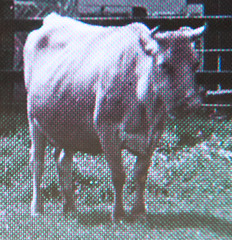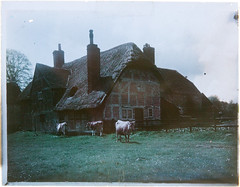Difference between revisions of "Paget plate"
(added note about speed of the plates) |
m |
||
| Line 32: | Line 32: | ||
</div> | </div> | ||
| − | '''Paget plates''' were an early colour photographic medium, similar in principle to [[Autochrome]] plates. The system was patented in 1912 by G.S. Whitfield, and sold by the Paget Prize Plate Company (which later was one of the companies that merged to form [[APM]]. They were renamed 'Duplex' plates from about 1920.<ref name=AWM>Short explanation of the [http://www.awm.gov.au/exhibitions/captured/colour/paget.asp Paget plate] process for an exhibition at the [http://www.awm.gov.au/ Australian War Memorial] of photographs from the First World War using it, and including photos by Frank Hurley, who was a war photographer in the First and Second World Wars.</ref>. The process was further developed as the Finlay plate in 1929, but chromogenic processes ([[Kodachrome]] and Agfacolor) largely replaced such processes within a few years.<ref name=Lumchron>[http://www.autochromes.culture.fr/index.php?id=126&L=1 Chronology of colour processes] at [http://www.autochromes.culture.fr/index.php?id=1&L=1 Autochromes Lumière], a project of the French Ministry of Culture.</ref> | + | '''Paget plates''' were an early colour photographic medium, similar in principle to [[Autochrome]] plates. The system was patented in 1912 by G.S. Whitfield, and sold by the Paget Prize Plate Company (which later was one of the companies that merged to form [[APM]]. They were renamed 'Duplex' plates from about 1920.<ref name=AWM>Short explanation of the [http://www.awm.gov.au/exhibitions/captured/colour/paget.asp Paget plate] process for an exhibition at the [http://www.awm.gov.au/ Australian War Memorial] of photographs from the First World War using it, and including photos by [[:Category:Image_by_Frank_Hurley|Frank Hurley]], who was a war photographer in the First and Second World Wars.</ref>. The process was further developed as the Finlay plate in 1929, but chromogenic processes ([[Kodachrome]] and Agfacolor) largely replaced such processes within a few years.<ref name=Lumchron>[http://www.autochromes.culture.fr/index.php?id=126&L=1 Chronology of colour processes] at [http://www.autochromes.culture.fr/index.php?id=1&L=1 Autochromes Lumière], a project of the French Ministry of Culture.</ref> |
Like Autochrome, the Paget plate was a monochrome plate, exposed through a three-colour filter screen. The image produced was essentially three interlaced images taken though different colour filters. The plate was developed as a positive (i.e. by a [[reversal processing|reversal process]]) and then viewed or projected, again with a colour filter screen to convert these three component monochrome images back to their colours. The three component colour images combined to make a true colour image. This kind of method is known as ''additive'' colour synthesis, in contrast to the subtractive method used in later colour-positive processes such as Kodachrome. | Like Autochrome, the Paget plate was a monochrome plate, exposed through a three-colour filter screen. The image produced was essentially three interlaced images taken though different colour filters. The plate was developed as a positive (i.e. by a [[reversal processing|reversal process]]) and then viewed or projected, again with a colour filter screen to convert these three component monochrome images back to their colours. The three component colour images combined to make a true colour image. This kind of method is known as ''additive'' colour synthesis, in contrast to the subtractive method used in later colour-positive processes such as Kodachrome. | ||
Revision as of 13:40, 11 May 2011

|
| John Vincent, bosun of the Endurance, mending a net, 1915. Paget plate in the collection of the State Library of New South Wales. image by Frank Hurley (Image rights) |

|
| Detail of the photograph showing the Paget screen's distinctive pattern. image by whatsthatpicture (Image rights) |

|
Paget-process photograph of a thatched house in Corhampton, Hampshire, England, by an unidentified photographer. image by whatsthatpicture (Image rights) |
Paget plates were an early colour photographic medium, similar in principle to Autochrome plates. The system was patented in 1912 by G.S. Whitfield, and sold by the Paget Prize Plate Company (which later was one of the companies that merged to form APM. They were renamed 'Duplex' plates from about 1920.[1]. The process was further developed as the Finlay plate in 1929, but chromogenic processes (Kodachrome and Agfacolor) largely replaced such processes within a few years.[2]
Like Autochrome, the Paget plate was a monochrome plate, exposed through a three-colour filter screen. The image produced was essentially three interlaced images taken though different colour filters. The plate was developed as a positive (i.e. by a reversal process) and then viewed or projected, again with a colour filter screen to convert these three component monochrome images back to their colours. The three component colour images combined to make a true colour image. This kind of method is known as additive colour synthesis, in contrast to the subtractive method used in later colour-positive processes such as Kodachrome.
In an Autochrome plate, the filter screen is attached permanently to the plate. With the Paget system, however, a separate glass screen is used (it is inserted in front of the plate in the dark slide). This has the advantage that different screens can be used for taking and viewing the photographs. A less strongly coloured filter was used for the 'taking' screen, increasing the effective speed of the plate;[3] their slow speed was a major disadvantage of early colour processes. The pattern of the colour screen also differs from the Autochrome plate, being a regular array of red, blue and green, rather than the Autochrome's random array of coloured dots. The 'viewing' filter screen had to be lined up perfectly with the plate for the colour image to be correct; once aligned, the 'viewing' screen would be fastened to the plate. The 'taking' screen, however, would be reused for every exposure. Special plate holders were available that allowed the screen to be inserted and removed in daylight, so that a dark bag was not needed in the field.
Notes
- ↑ Short explanation of the Paget plate process for an exhibition at the Australian War Memorial of photographs from the First World War using it, and including photos by Frank Hurley, who was a war photographer in the First and Second World Wars.
- ↑ Chronology of colour processes at Autochromes Lumière, a project of the French Ministry of Culture.
- ↑ The caption to a Paget photograph by Sarah Acland states that the Paget plate was two stops faster than Autochrome; in the exhibition Cameras: the Technology of Photographic Imaging at the Museum of the History of Science, Oxford, 20 May - 13 September 1997.